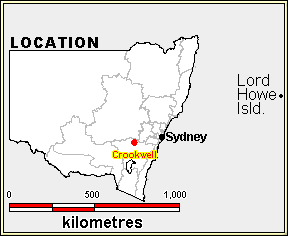Click on the map below for a more detailed location
 Crookwell lies north of Goulburn high atop the western slope of the Great Dividing Range.
Crookwell lies north of Goulburn high atop the western slope of the Great Dividing Range.
The discovery of this rich farming country followed on from the journeys of exploration by Throsby and Meehan (1828) in search of an inland route to the settlement at Bathurst to the north. By this time some of the great early landholding families (Macarthur, MacAlister, Howe) had already established themselves on large grants at nearby Taralga.
The earliest settlement in the Crookwell area, however, seems to have been by squatters between 1828 and the 1850s that grew wheat and potatoes and grazed stock on the native grasses.
During the first 30 years of settlement a number of villages were established throughout the Crookwell district ((Binda, Bigga, Laggan, Grabben Gullen etc.) to serve the adjacent farming areas. Development did not really come until after the Selection Act of 1861, when a large number of settlers took up land.
The main street was laid out in 1869 and a plan was put in place to develop the town whose population grew from just 130 in 1864 to over a thousand eight years later.
The 1870s were days of prosperity and growth for Crookwell. A passenger coach ran regularly to Goulburn, and the district grew rich on the oats, wheat, cattle, potatoes and sheep of its farms, the first local agriculural show being held in 1879. Crookwell continued to grow steadily over the next 20 years, the arrival of large numbers of Irish immigrants reflected in the building of St. Mary's Church, as was the increase in smaller farm holdings devoted to dairying and vegetable growing.
By the early 1900s Crookwell was the centre of the entire region and its major town - Crookwell Shire being established in 1906, and a district hospital opened in the same year Crookwell was of sufficient importance for a branch railway line to be built from Goulburn in 1901 and had become a major rural centre. Crookwell is also significant in being the home of the Country Womens' Association - the first CWA being formed here in 1922.
The first half of the 20th century saw Crookwell suffer the same vicissitudes as other rural centres - a rabbit plague in the 1910s devastated crops and pasture lands, hardly alleviated by a processing and freezing works in the town which shipped the carcasses to the 'starving masses' in England and the skins to hat makers. The Great Depression, two world wars, and the increasing centralisation and industrialisation of the nation all took its toll.
By the middle of the century Crookwell was still catching up on the necessities of modern life - electricity (1947), sealed roads (1954), sewerage (1961), a High School (1963). The nature of its agriculture also changed and changed the town along with it. Small holdings, along with dairying and the butter factory it supported became unviable, to be replaced by potato growing on a large scale.
The countryside was not suitable for large scale wheat growing, and the oats and barley which once fed a horse-drawn age became obsolete. Landholdings became larger - though not as large as the great runs of the original squatters - and specialised in fine wool production and stud cattle.
The population of Crookwell is today only twice what it was over 120 years ago. Its position as regional centre to its rural hinterland has been usurped by Goulburn - now just a short drive away.
As it enters the 21st century the nature of its industry has changed: still farming, a weaving mill and famous sock factory, local retail and service industries, and tourism.
All Rights Reserved.